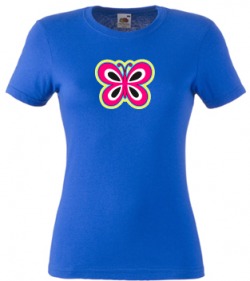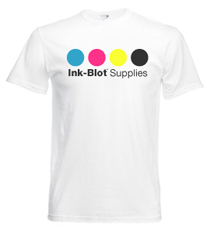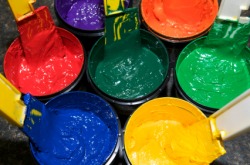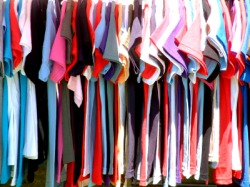T Shirt Printing Starts With..

T shirt printing, like this, is not necessarily limited to using a screen or mesh to apply textile ink to create the t shirt design. Custom printed t shirts particularly require the use of a combination of methods and specific inks to achieve the kind of effect the customer wanted. One of the methods used in combination with screen printing is discharging, which is the removal of colors or dyes from the fabric using chemicals.
Discharging can create earthy colors or reveal the original color of the fabric. Creative people have used discharging to liven up their old clothes. It does not cost a lot and it does not require the use of equipment. All that are needed are bleaching agents or reducing agents to bleed the color from certain areas of the fabric. Usually stencils are used to create patterns and images on the fabric.
Discharging can create earthy colors or reveal the original color of the fabric. Creative people have used discharging to liven up their old clothes. It does not cost a lot and it does not require the use of equipment. All that are needed are bleaching agents or reducing agents to bleed the color from certain areas of the fabric. Usually stencils are used to create patterns and images on the fabric.
Preparing The Discharge Agents And The Neutralizing Solutions

Discharging using common household bleach is easy. Either the store-bought variety or the purely concentrated industrial bleach will do well for the task. If you choose to use household bleach, you have to check the bleaching strength of the product.
If the bleach is diluted, then you would need to thicken it using Monogum or a bleach thickener. The best tool for discharging, however, is the Clorox Bleach Pen. It is already made with thickened bleach. You also have the choice of using liquid detergents because they have bleach and thickeners in them.
Prepare your neutralizer even before you start discharging. Neutralizers will wash off bleach residue from the fabric to prevent damage. To neutralize bleach, mix one part hydrogen peroxide with 10 parts water and soak your fabric in this solution for about 10 minutes. Another method is to use Anti-Chlor, which is made of sodium bisulfate and can be ordered by mail from PRO Chemical & Dye. One teaspoon of Anti-Chlor per one quart of water is enough for one neutralizing solution.
If the bleach is diluted, then you would need to thicken it using Monogum or a bleach thickener. The best tool for discharging, however, is the Clorox Bleach Pen. It is already made with thickened bleach. You also have the choice of using liquid detergents because they have bleach and thickeners in them.
Prepare your neutralizer even before you start discharging. Neutralizers will wash off bleach residue from the fabric to prevent damage. To neutralize bleach, mix one part hydrogen peroxide with 10 parts water and soak your fabric in this solution for about 10 minutes. Another method is to use Anti-Chlor, which is made of sodium bisulfate and can be ordered by mail from PRO Chemical & Dye. One teaspoon of Anti-Chlor per one quart of water is enough for one neutralizing solution.
Not All Colors Discharge Equally

Not all colors discharge the same amount. There are dyes that bleed a little and require thicker bleach concentrations. A dye’s discharge ability is rated from one to five and is based on the activity of zinc formaldehyde sulfoxylate.
A dye color with a rate of five will discharge to white, but those with lower rates will lose only a portion of their color and turn to a lighter shade of the color. For example, a dark green shirt may turn to apple green or light green when discharged. Knowing this information will help you design your pattern better in discharging. You can also plan beforehand which colors to use in your inks for screen printing to achieve a certain shade or effect.
Some colors, like turquoise in reactive dyes, will not discharge at all. Some colors, like turquoise in reactive dyes, will not discharge at all. Mix the discharge agent to a turquoise dye solution, apply it to purple fabric, steam set or heat press, and you leave behind the turquoise in a field of purple.
A dye color with a rate of five will discharge to white, but those with lower rates will lose only a portion of their color and turn to a lighter shade of the color. For example, a dark green shirt may turn to apple green or light green when discharged. Knowing this information will help you design your pattern better in discharging. You can also plan beforehand which colors to use in your inks for screen printing to achieve a certain shade or effect.
Some colors, like turquoise in reactive dyes, will not discharge at all. Some colors, like turquoise in reactive dyes, will not discharge at all. Mix the discharge agent to a turquoise dye solution, apply it to purple fabric, steam set or heat press, and you leave behind the turquoise in a field of purple.
Using Bleaching Paste For Discharging

Application of your discharge agent can be done through printing, stamping, or drawing the design directly on the fabric. However, before you do this, the discharge agent has to be turned into paste. A standard printing paste can be made by mixing two parts of bleach to five parts water. Thicken the solution by mixing in 1 tablespoon of monogum to one-half cup of the liquid.
T shirt printing can begin when you have finished preparing the required solutions and mixes. Use the discharge agent quickly, or else the bleach will break down the other ingredients in the solution. Reducing agents are not particularly stable in water and last only for a few hours.
Once you are done with the screen printing, immediately neutralize the bleach from your fabric using the same procedure as indicated above. As an alternative, you may also apply the neutralizing solution to the bleached area first to stop the corrosive action of bleach before soaking and rinsing the fabric in the solution. The t shirt printing process ends with washing and rinsing off the remnants of the bleach from the t shirt.
T shirt printing can begin when you have finished preparing the required solutions and mixes. Use the discharge agent quickly, or else the bleach will break down the other ingredients in the solution. Reducing agents are not particularly stable in water and last only for a few hours.
Once you are done with the screen printing, immediately neutralize the bleach from your fabric using the same procedure as indicated above. As an alternative, you may also apply the neutralizing solution to the bleached area first to stop the corrosive action of bleach before soaking and rinsing the fabric in the solution. The t shirt printing process ends with washing and rinsing off the remnants of the bleach from the t shirt.
